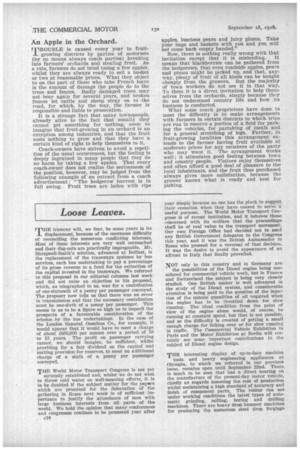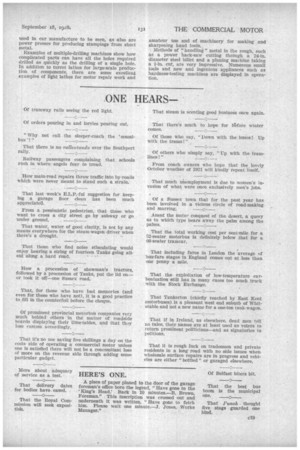Loose Leaves.
Page 2

Page 3

If you've noticed an error in this article please click here to report it so we can fix it.
rpHE tramcar will, we fear, be some years in its
displacement, because of the enormous difficulty of reconciling the numerous conflicting interests. Most of these interests are very well entrenched and their dug-outs are practically impregnable. Mr. Shrapnell-Smith's solution, advanced at Belfast, is the replacement of the tramways systems by bus services, each bus undertaking to pay a percentage of its gross revenue to a fund for the extinction of the capital invested in the tramways. We referred to this proposal in our editorial columns last week and did not raise an objection to his proposal, which, as telegraphed to us, was for a contribution of one-sixteenth of a penny per passenger conveyed. The proposer now tells us that there was an error in transmission and that the necessary contribution must be one-sixth of a penny per passenger. This seems to us to be a figure so high as to imperil the prospects of a favourable consideration of the scheme by the bus undertakings. In the case of the London General Omnibus Co., for example, it would appear that it would have to meet a charge of about £850,000 per annum over a period of 10 to 15 years. The profit on passenger carrying cannot, we should imagine, be sufficient, whilst providing for a fair dividend on the capital and making provision for reserves, to meet an additional charge of a sixth of a penny per passenger conveyed.
THE World Motor Transport Congress is not yet seriously established and, whilst we do not wish to throw cold water on well-meaning efforts, it is to be doubted if the subject matter for the papers which are promised for the delectation of the gathering in Rome next week is of sufficient importance to justify the attendance of men with large business interests from all parts of the world. We hold the opinion that many conferences and congresses continue to be promoted year after 018 year simply because no one has the pluck to suggeSt their cessation when they have ceased to serve a useful purpose. The World Motor Transport Congress is of recent institution, and it behoves those concerned with its welfare that the proceedings shall be of real value to the transport movement. Our own Foreign Office had decided not to send any British Government delegates to the Congress this year, and it was the British Ambassador in Rome who pressed for a reversal of that decision. It was the desire to avoid the appearance of an affront to Italy that finally prevailed.
NOT only in this country and in Germany are the possibilities of the Diesel engine being considered for commercial vehicle work, but in France and Switzerland the subject is being very closely studied. One British maker is well advanced in the study of the Diesel system, and considerable attention is being paid to the question of the injection of the minute quantities of oil required when the engine has to be throttled down for slow running. The ideal condition from the point of view of the engine alone would, of course, be running at constant speed, but that is not possible, and so the difficulty is created of getting a small enough charge for ticking over or for slow running in traffic. The Commercial Vehicle Exhibition in Paris and the Motor Exhibition at Berlin will certainly see some important contributions to the subject of Diesel engine design.
THE interesting display of up-to-date machine
tools and heavy engineering appliances at Olympia, to which we referred in our previous issue, remains open until September 22nd. There is much to be seen that has a direct bearing on the manufacture of the present-day motor vehicle, chiefly as regards lessening the cost of production whilst maintaining a high standard of accuracy and finish of component parts. The visitor can see under working conditions the latest types of automatic grinding, milling, boring and drilling machines. There are heavy drop hammer machines for producing the numerous steel drop forgings used in car manufacture to he seen, as also are power presses for producing stampings from sheet metal.
Examples of multiple-drilling machines show how complicated parts can have all the holes required drilled as quickly as the drilling of a single hole. In addition to turret lathes for large-scale production of components, there are some excellent examples of light lathes for motor repair work and amateur use and of machinery for making and sharpening hand tools., Methods of handling" metal in the rough, such as a power hack-saw cutting through a 24-in. diameter steel billet and a planing machine taking a i-in. cut, are very impressive. Numerous small tools and new and ingenious appliances such as hardness-testing machines are displayed in opera' tion.
































